Today, on the 50th anniversary of the deal that shook football to its very foundations, here is an instalment from 'Out of the Blue' which details the behind-the-scenes manouverings which led to Ron Barassi’s audacious appointment as Carlton captain-coach.
On the evening of Tuesday, February 16, 1965, at Princes Park, the late Gerard Burke took a phone call which would dramatically alter the course of both the Carlton and Melbourne Football Clubs, and indeed, football itself.
After what is a brief exchange with his Melbourne counterpart Jim Cardwell, secretary Burke replaced the telephone on its receiver and turned to Ronald Dale Barassi and members of the Carlton committee and said: “He (Barassi) is okay. Melbourne says ‘cleared with our good wishes’.”
The signing of Barassi as captain-coach of the Carlton Football Club in 1965 undeniably remains the most audacious signing in league history. How did Carlton, on the end of its worst standing in 100 seasons of existence, wrest the game's greatest name from clutches of the Melbourne establishment?
Over the years, many have laid claim to their part in the push to “Get Ron” from the Redlegs to deliver the old dark Navy Blues from the football backwater. Back in 1995, when surviving members of George Harris’ famed Progress Party gathered for the 30th anniversary of “Barassi to the Blues”, all magnanimously declared it a joint effort.
In truth, the push for Barassi was on in earnest months before the Progress Party swept into power at Princes Park - and central to it were two leviathans of the city’s business sector, a prominent Melbourne solicitor and a fearsome former Carlton footballer who forged an equally imposing reputation as both a powerbroker and a kingmaker.
The four men - Sir Leo Curtis, Sir Maurice Nathan, Graeme Emanuel and Laurie Kerr – were also bound by an unswerving loyalty to the Carlton Football Club.
A story which in part tells the whole in respect of their unqualified allegiance relates to Sir Leo and Sir Maurice. It is a tale told by Ken Hands, who was six seasons into his senior coaching tenure when forced to make way for Barassi.
Hands, a dual Carlton premiership player whom John Nicholls long regarded as his mentor, can well recall the pair rubbing shoulders with well-heeled supporters as far back as the war years.
“I don’t know what it’s like now, but a lot of supporters used to come into the rooms afterwards – people like Maurie Nathan and Leo Curtis,” Hands recalled.
“There was a group who used to meet over lunch in Lonsdale Street before Carlton games. They’d have their little punt on the game, and quite often through ’45 and ’47, if we won, we’d probably get an extra couple of quid.
“That’s how the money came about. Perc Bentley might announce ‘If you win by three goals today there’s two pound a man’, and if you’d get three quid to play and two quid on the side, it was pretty good.”
Sir Leo, Sir Maurice, Emanuel and Kerr have all since died, and, at the time of writing, only three members of the Progress Party – Lloyd Bendall, Gordon Newton and Ivan Rohrt – are still around to shed any light on the stunning coup to secure Barassi on a three-year term at a cost of £9000 plus bonuses.
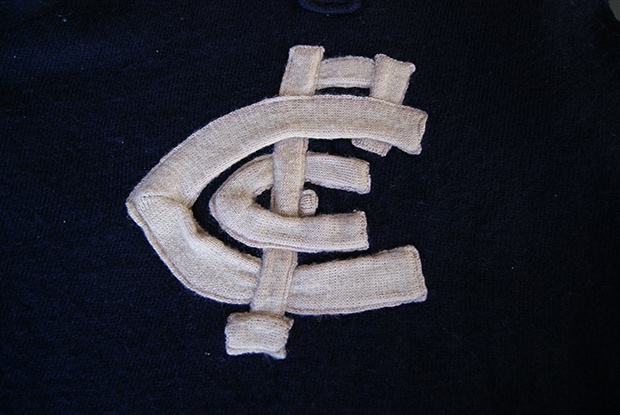
A close-up of Ron Barassi's famous Carlton guernsey. (Photo: Simon Davis collection)
But Kerr’s widow and the Carlton’s Football Club’s No.1 female ticketholder Vivienne Kerr, together with the great Ronald Dale himself, have drawn on their collective memories to detail the behind-the-scenes machinations which ultimately led to football’s most audacious signing.
“Maurice Nathan loved Laurie, and Leo was one of our dearest friends. I always used to go to the footy with Leo and Maurice Nathan and we’d sit together. Laurie delivered a speech at Leo’s 90th birthday party, we were all best friends and a great part of our friendship was our love of the club,” Vivienne said.
“In mid-1963 - I can’t remember the date but one Sunday night - Sir Leo Curtis phoned Laurie. The discussion went that perhaps Laurie might sound Ron Barassi out, so Laurie arranged a luncheon with Ron, I think at the Hotel Australia.
“Laurie was very satisfied emerging from the lunch. He didn’t put Ron in an embarrassing position by saying ‘This is what you must do’. It was just to sow the seed. This was what Laurie did, and that was how he operated. He did some amazing things in his life.
“It was maybe 10 months later that Ron was approached by Graeme Emanuel and Kevin McEncroe on behalf of all members of the [Carlton Football Club] board to put the thing to Ron.”
Vivienne said that her husband and Barassi had forged a lifelong friendship when the two were locking horns in Carlton-Melbourne contests through the Redlegs’ halcyon days of the 1950s.
“Laurie and Ron had built a rapport with each other from their playing days, and Ron delivered the eulogy at Laurie’s funeral,” Vivienne said. “Ron said that the first time he met Laurie ‘was when his shoulder hit mine’, and they were both pretty tough, but they had a great, great relationship.”
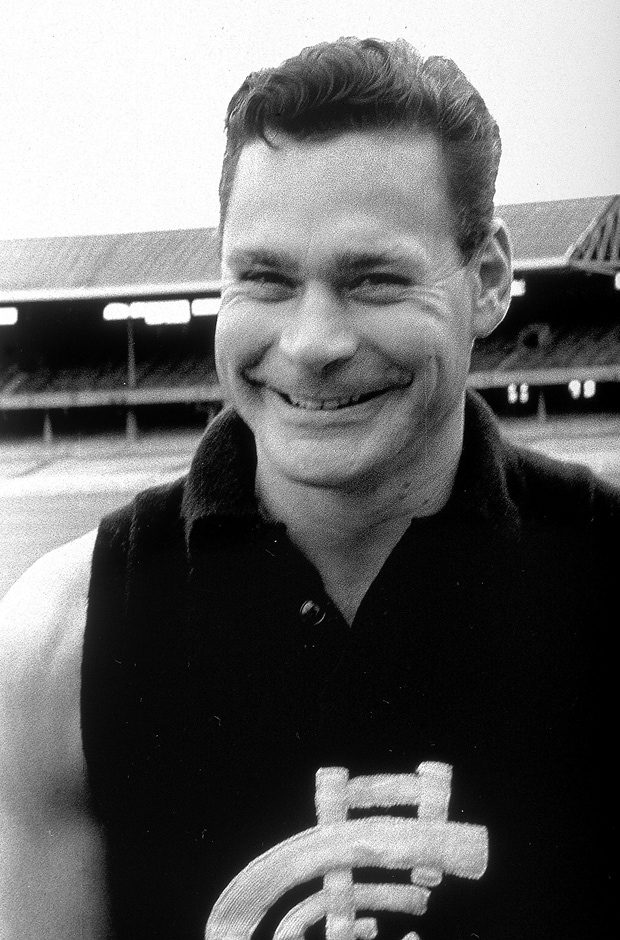
Barassi poses for a happy snap at the MCG in 1966. (Photo: Carlton Football Club)
There can be no doubting Barassi’s great respect for Kerr. Once asked to name his heroes in life, the game’s famous No.31 volunteered Rupert Murdoch “for proving himself in a diabolically competitive field”, Herb Elliott as “a fantastic guy, and his own man”, Barry Jones, for “a sense of humour and top Australian” and Laurie Kerr for his “ability to get people with him, and a good listener, but tough”.
Barassi has also concurred with Vivienne’s take on this chain of events, including the pivotal rendezvous with Kerr at the Hotel Australia.
“Laurie Kerr rang me up and said ‘What about going to lunch?’ I said yes [to the luncheon engagement] because I really admired his qualities as a person and as a footballer,” Barassi said.
“We’d played interstate football together and we’d had battles on the field, but not centreman versus centreman as I was too scared to go into the centre to go against him (laughs).
“I left Laurie about 90 minutes later let’s say, and as I was getting into my car I thought ‘Why would he take me to lunch?’. There was no relevant discussion during the lunch or reason behind it, and I always took it that he [Kerr] was sizing me up for the coaching position.
“I always thought that happened during 1963, but it could have happened in ’64 and I’m not certain on that point - either way, it was certainly some time before the coaching thing came up as a definite proposition.”
Barassi said he never knew that Kerr, Curtis, Nathan and Emanuel had, from the outset, volunteered his name as a prospective Carlton coach.
Vivienne, meanwhile, has denied that the Barassi plan was hatched by Curtis alone, insisting that “they [the clique] would have all chatted about it”.
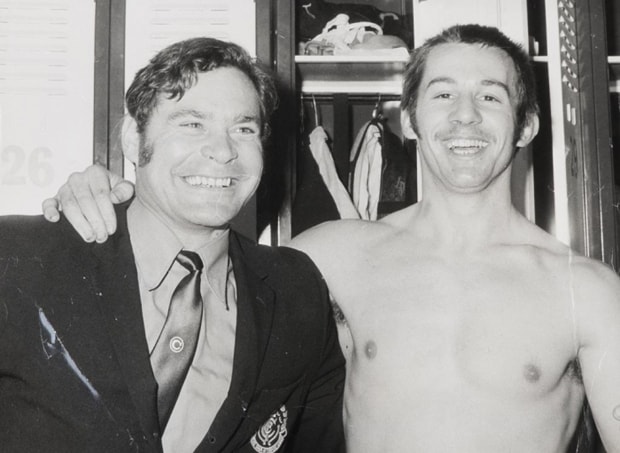
Ron Barassi and Brent Crosswell celebrate another Carlton win. (Photo: Carlton Football Club)
“Laurie, Leo Curtis, Maurice Nathan and Graham Emanuel were probably the only ones who knew [about Barassi]. The point was that the team was going nowhere and the club was still experiencing the destabilising effects of the Hands-Francis fallout. There’d been all this fighting and upheaval, and they [the club] needed a lift,” Vivienne said.
She also remembered that the initial plan to get Ron was concocted independently of Harris for the simple reason that Harris’s Progress Party had not yet been swept into office. However, she believed that Kerr informed the-then Carlton president Lew Holmes of his initial meeting with Barassi.
It’s worth noting here that Sir Edward Leo Curtis was, at the time, the Lord Mayor of Melbourne. Sir Leo had forged his handsome reputation as the director of Bradman’s Stores, served as President of the Retail Traders Association, and was also a member of the advisory board of the Mercy Maternity Hospital.
Sir Maurice Arnold Nathan, the chairman of the furniture retailing firm Patersons, preceded Sir Leo as Lord Mayor of Melbourne. He served from 1961-63, about the same period that John F. Kennedy occupied the White House.
By the time Sir Maurice had hung up his chains, the long-serving councillor had actively involved himself in the establishment of Tullamarine Airport, Moomba and the Southern Cross Hotel, and had also headed the Melbourne Olympic Games organising committee.
He would also serve as the VFL chairman and a racing industry board member and formed the Victorian Promotion Committee (the original Victorian Major Events Company) with the-then Premier Sir Henry Bolte.
Graham Emanuel, according to club records, was elevated to the vacant position on the Carlton committee on October 10, 1961. The vacancy had been created following the sudden death on September 12 of Harvey Dunn senior, a former Carlton footballer in the 1920s whose son Harvey junior was the first League footballer recruited under the father/son rule. Ronald Dale Barassi, as it happened, was the second.
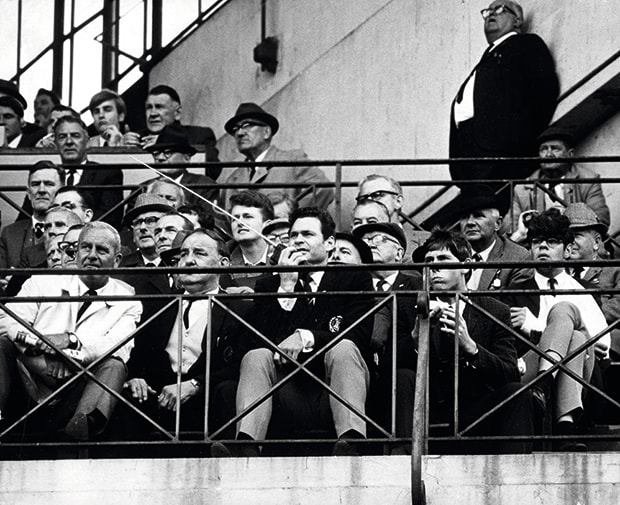
Ron Barassi relays instructions during the 1968 Grand Final. (Photo: Carlton Football Club)
Emanuel, who would also serve as a member of the club’s finance committee and as an honorary Carlton Ground Representative, was described in the 1961 annual report as “a professional man of standing”, with the club expressing every confidence “that he will prove an acquisition to our administrative ranks”.
And then there was Laurie Kerr.
Kerr was born Lawrence Kitchin-Kerr on June 25, 1928. Legend has it that he opted for the abridged version of his surname so that it would fit in the Footy Record.
Named as an emergency in the Carlton Football Club’s exalted Team of the Century, Kerr represented the old dark Navy Blues in 149 senior matches between 1950-59. He also pursued a career in journalism, and in the years following his retirement steadily built his public relations empire IPR.
Somewhat paradoxically, Kerr preferred to work in the background. Regardless, he was universally acknowledged in his extraordinary lifetime as one of the country’s great movers and shakers, and the Carlton Football Club was not untouched.
Few would know that Kerr originally supported Collingwood and that his links with Carlton were first forged through Vivienne, who in her childhood years shared her mother’s allegiance to the now-defunct Fitzroy.
“As a wee kid I used to be taken to the footy to watch Fitzroy and Haydn Bunton because Bunton, Frank Curcio and ‘Chicken’ Smallhorn were my mother’s heroes,” Vivienne said. “Laurie loved Collingwood, and he used to ride his bike from Kew to Collingwood, chain his bike up and watch the team play.
“I barracked for Fitzroy before Laurie went to Carlton. I saw the last premiership Fitzroy won. I remember Fred Hughson, Noel Jarvis and Alan Ruthven, and they’re the ones that Laurie subsequently played against.”
Vivienne said that she and Kerr married young. “We had a child and very nearly another, and at that time he was a reporter for The Argus and they sent him to university to do his BA,” she said.
“He was a professional runner and he also played football for Auburn, but not all the time. He was too busy with his studies and they [Auburn] only got him to play when they needed him.”
Vivienne revealed that the first Carlton overtures came when The Argus posted her husband to Canberra to cover parliament.
“My father, Harry Devine, idolised Laurie and couldn’t believe that into his family had come this fellow who was fast and who could kick a football. My Dad had played footy for Carlton and Fitzroy seconds … and he knew Harry Bell, the secretary of Carlton, very well,” Vivienne said.
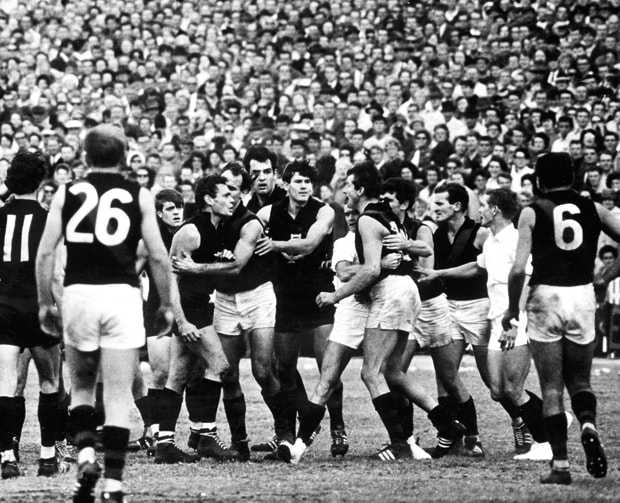
Barassi flies the flag against the Bombers. (Photo: Carlton Football Club)
“My father said to Harry: ‘Laurie’s very good’, and he’d already mentioned the same to Ken Luke because Ken Luke was one of my Dad’s best and oldest friends.”
Vivienne said that on Kerr’s return from Canberra, her father arranged for Bell to visit the home of Laurie and Vivienne in Ivanhoe. She said that following an interview with Bell, Kerr begrudgingly agreed to front for a training session at Princes Park.
“Laurie ran around once while Ken Luke, Harry Bell and Newton Chandler were watching. It was not long after the premiership year, and they needed a new wingman,” Vivienne said.
“Anyway, they called him over and Ken Luke said: ‘You’re in – you’ll be playing in the first game on the wing’. Laurie graduated at Melbourne Uni on the day of the last practice match, and he raced over to Carlton and he played. He sprained his ankle and wasn’t able to play for another 12 weeks, but as soon as he got fit he broke into the Carlton team, against North Melbourne.”
Kerr’s contribution to the Carlton team encompassed all of the 1950s, but it could be successfully argued that his influence was greater in the years after he hung up the No.11 guernsey.
“The Carlton Football Club was everything to Laurie. Playing football for Carlton meant a lot to him,” Vivienne said. “He was loyal to Carlton, loved Carlton and tried to help Carlton in any way that he could. He gave his all for the club.”
Vivienne said that while her late husband never divulged the details of his conversation with Barassi at the Australia Hotel, “I knew what was happening and that they [the Sir Leo Curtis clique] wanted Ron to go [to Carlton].
“I never pried into his [Kerr’s] business but I know why he was approaching Ron, for sure,” she said.
“If Laurie wanted to tell me these things, he would. He definitely told me why he was approaching Ron, and I said ‘Ripper!’.
“It was terrific when Ron came to Carlton. Mind you, I could have killed him when he played for Melbourne. He was so fierce and aggressive.”
A famous photograph captured in the rooms before Carlton’s practice match against St Kilda in early 1965 shows Barassi, hands on hips and resplendent in navy blue strip, delivering the edict to a captive audience of senior players. Behind Barassi can be found a plethora of football identities, from the President George Harris through to the resident club barber Ernie Angerame and the ever-vigilant newshounds Alf Brown and Ron Carter. Also there, head bowed, is Ken Hands, the man who made way for Ronald Dale.
Barassi was one of four men – all of them untried as coaches – known to have been interviewed for the Carlton job. Collingwood’s Murray Weideman, along with Essendon’s Jack Clarke and Bill Hutchison, were all in the mix, but Barassi was the peach. Undeniably, Barassi was torn by his historical links to the grand old flag for whom he and his father so grandly represented, but Harris was relentless in making the great grandson of an Italian migrant an offer he couldn’t refuse.
Ronald Dale Barassi was officially appointed captain-coach of the Carlton Football Club on the night of Thursday December 22, 1964. But more than a month lapsed before Melbourne granted its long-serving premiership player a clearance.
On the night the paperwork finally came through, Barassi was photographed flanked by committeemen Harris, Emanuel, Eddie Fakhry and Rod McLean, each one of them fawning over the club’s recruit of the year.
“As a coach, I have no revolutionary ideas,” Barassi told reporters privy to what was history in the making, “but my ideas are proven ones and I am confident they will work at Carlton.
“I will try to mould the perfect team. No-one has achieved this yet, but if you aim high I think you have a better chance of success.”
Barassi commandeered Carlton to its breakthrough premiership of 1968 and its stunning Grand Final victory in 1970. John Nicholls, who accepted the prized cup on both occasions, said that his old coach brought much of Norm Smith’s and Melbourne’s success and discipline to the table.
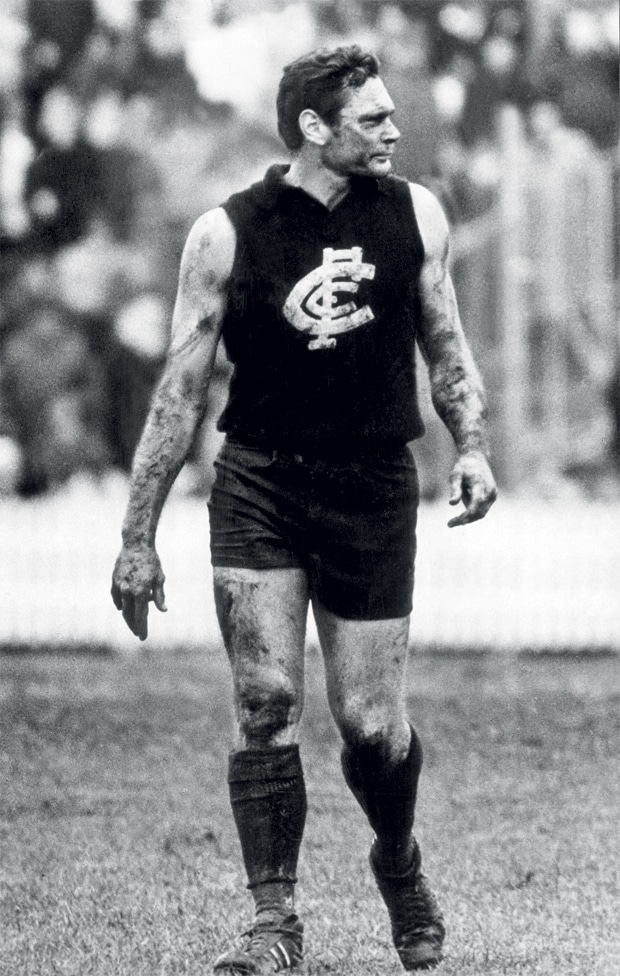
Barassi made a surprise comeback for one last game in Round 7, 1969, to complete 50 matches for Carlton. (Photo: Carlton Football Club)
“‘Barass’ was very, very good. He was very lucky in two areas – number one, we had the nucleus of a fantastic side which he helped mould, and the second thing was we had a fantastic match committee, of which Rod McLean was initially chairman, and then Jack Wrout, who was wonderful,” Nicholls said.
“Jack had the ability to walk around after Ron picking up the pieces because ‘Barass’ was like a bull in a china shop. He’d knock people down and ‘Wrouty’ would pick them up again.
“[George] Harris was good, the committee was good, Barassi was good and the players were good. And ‘Barass’ probably brought it all together.”
AFL Chairman and dual former Carlton premiership captain Mike Fitzpatrick, in recently proposing a toast to the club’s breakthrough team of 1968, said of Barassi’s legacy: “It’s history now that the Barassi era set off the most successful period in Carlton history – eight premierships over a 27-year period, beginning with the big one in ’68.
“Though Ron was untried in the coaching caper, Carlton knew exactly what it was getting – a ferocious competitor, a supreme motivator and above all else, a winner,” Fitzpatrick said.
“The 1968 Grand Final serves as a salient reminder that success at a football club can only be achieved when everyone from the President and the board, through to the administration, the coach and the players, are committed as one to the common cause.”



